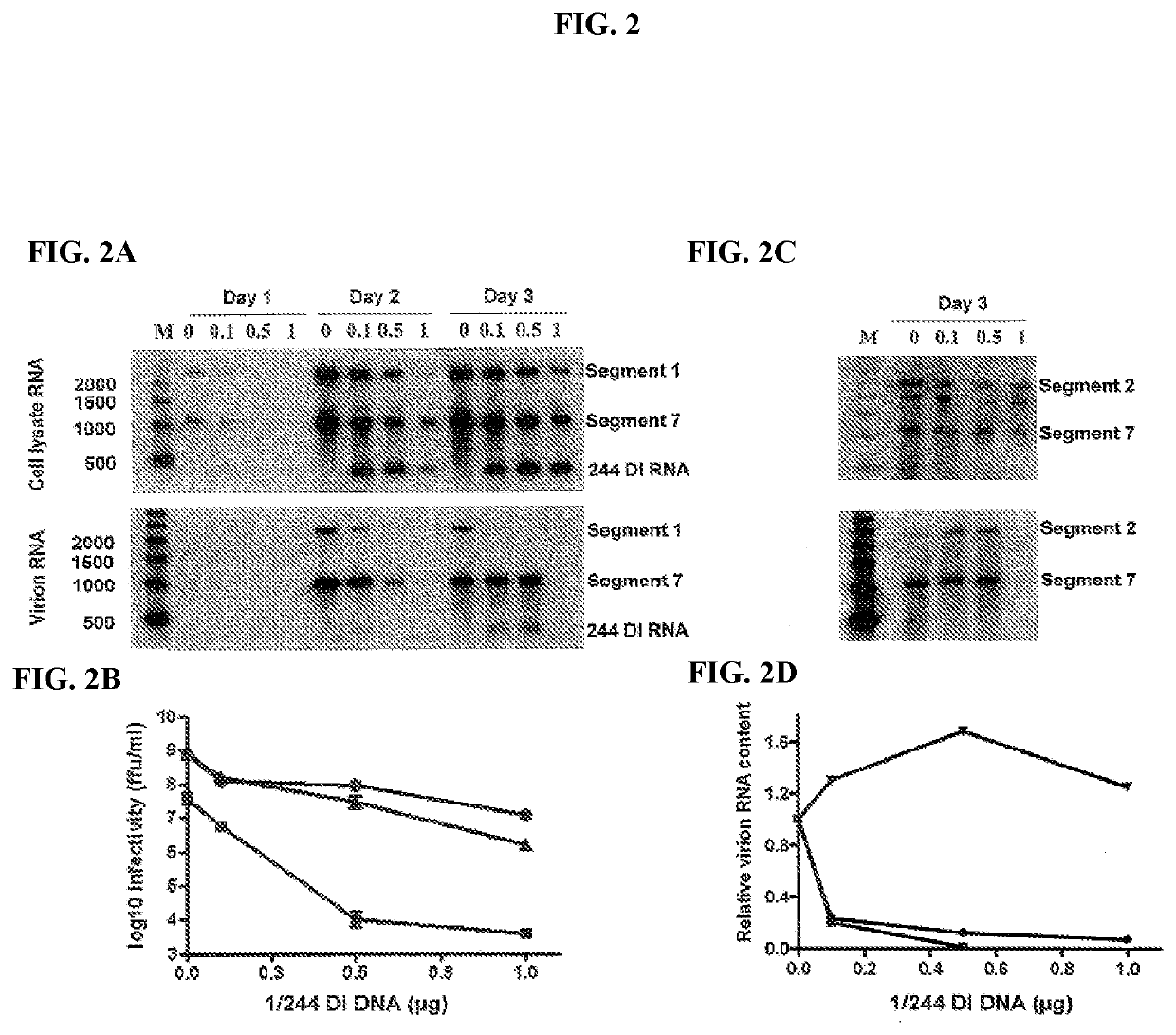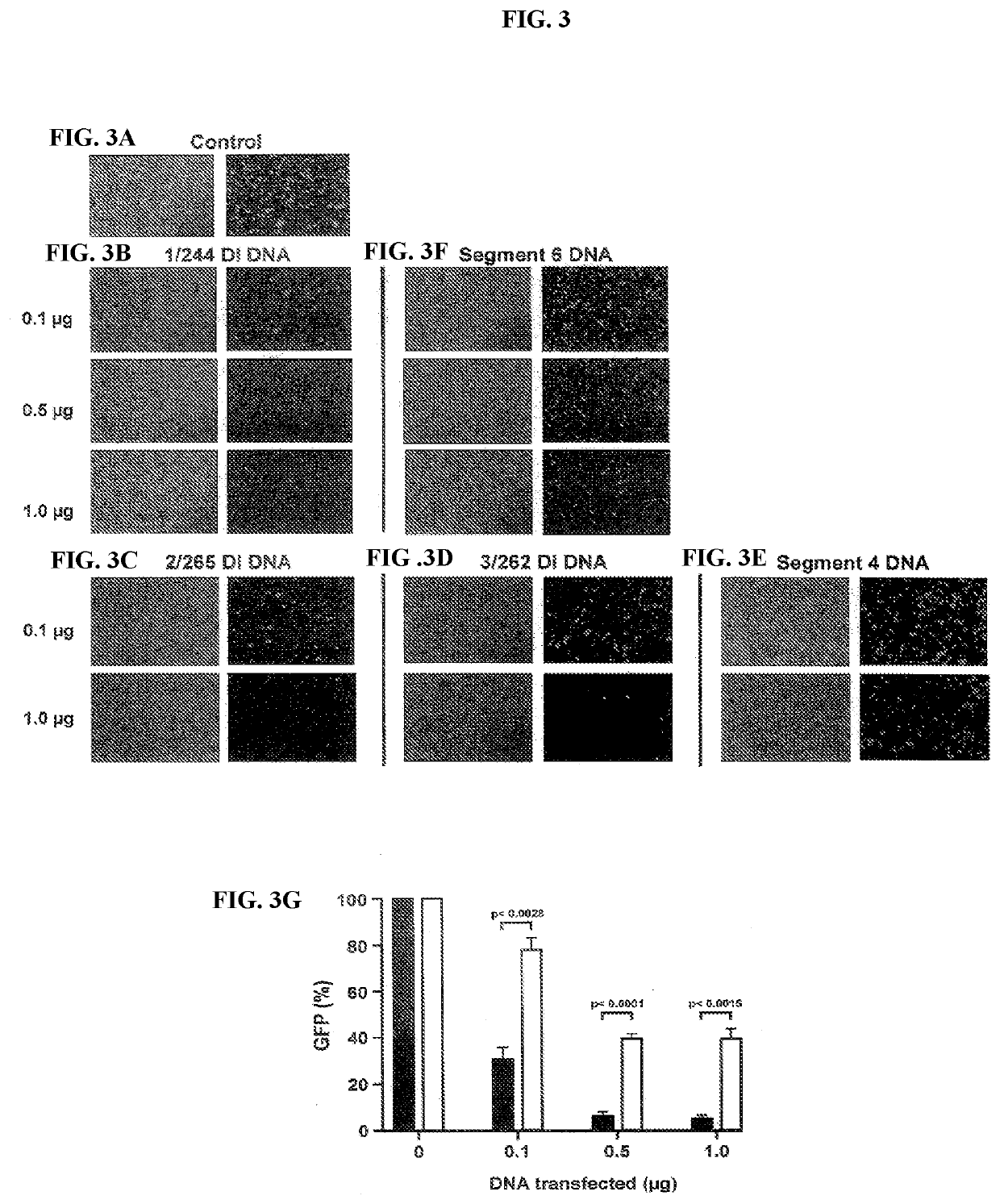Assay and medicament
a technology of antiviral agents and assays, applied in the field of assays and medicaments, can solve the problems of affecting the replication of di virus particles, malfunctioning, and inability to replicate autonomously of di virus particles
- Summary
- Abstract
- Description
- Claims
- Application Information
AI Technical Summary
Problems solved by technology
Method used
Image
Examples
example 1
DI RNA Inhibits RNA Production from Segments 1, 2 and 3
Materials and Methods
[0085]Plasmids
[0086]The plasmids encoding the 8 gene segments of the A / WSN strain of A / WS / 33 and plasmids expressing the polymerase proteins and NP (Neumann et al. 1999), and the vector expressing 1 / 244 DI RNA (FIG. 1) were as previously described (Duhaut and Dimmock 2002; Dimmock et al. 2008). 1 / 244 RNA comprises 395 nt and was derived from segment 1 of A / Puerto Rico / 8 / 34 (H1N1). The segment 1 target, segment 1-GFP, was created by amplifying the GFP ORF by PCR from pEGFP-N1(Clontech) using primers 5′ATGGTCTCTACTGATGGTGAGCAAGGGCGAG (SEQ ID NO: 11) and 5′ATGAAGACAATCTCTTACTTGTACAGCTCGTCCA (SEQ ID NO: 12). The product was inserted between the BpiI and Eco311 sites of pPolI-220 (Duhaut and Dimmock 2000) such that the GFP ORF is in-frame with the PB2 ORF, giving plasmid seg 1-GFP which expresses segment 1-GFP RNA (FIG. 1). The GFP reporter retains the exact 5′ (220 nt) and 3′ (48 nt) terminus of segment 1 and is...
example 2
Protein Expression Encoded by DI RNA is not Required for Interference
[0121]Material and methods
[0122]Plasmids and Production of Infectious Virus by Reverse Genetics
[0123]Plasmids encoding the 8 gene segments of the A / WSN strain of A / WS / 33 and plasmids expressing the polymerase and NP proteins (Neumann et al. 1999), and the vector expressing 244 DI RNA from Poll promoters have been previously described (Dimmock et al. 2008; Duhaut and Dimmock 2002). 244 RNA is 395 nucleotides and was derived from segment 1 of A / Puerto Rico / 8 / 34 (H1N1). The segment 1 target, segment 1-GFP, was created by amplifying the GFP ORF by PCR and inserting this into pPolI-220 (Duhaut and Dimmock, 2000) such that the GFP ORF was in frame with the PB2 ORF, giving plasmid seg 1-GFP which expresses segment 1-GFP RNA (Meng et al. 2012). The GFP reporter plasmid retains the exact 5′ (220 nt) and 3′ (48 nt) terminus of segment 1. Human 293T cells were transfected with plasmids as previously described (Dimmock et al. ...
PUM
| Property | Measurement | Unit |
|---|---|---|
| pH | aaaaa | aaaaa |
| total volume | aaaaa | aaaaa |
| length | aaaaa | aaaaa |
Abstract
Description
Claims
Application Information
 Login to View More
Login to View More - R&D
- Intellectual Property
- Life Sciences
- Materials
- Tech Scout
- Unparalleled Data Quality
- Higher Quality Content
- 60% Fewer Hallucinations
Browse by: Latest US Patents, China's latest patents, Technical Efficacy Thesaurus, Application Domain, Technology Topic, Popular Technical Reports.
© 2025 PatSnap. All rights reserved.Legal|Privacy policy|Modern Slavery Act Transparency Statement|Sitemap|About US| Contact US: help@patsnap.com



